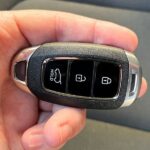Key fobs are incredibly convenient, allowing us to effortlessly lock, unlock, and even start our cars remotely. But what happens when your key fob stops working, or you need a replacement? Many car owners face the question: What Do I Need To Program Keys To Cars? Fortunately, in many cases, you can handle key programming yourself, saving time and money.
This guide will walk you through everything you need to know about programming car keys. We’ll cover the necessary tools, step-by-step instructions for DIY programming, when you might need professional help, and even touch upon the fascinating world of vehicle data accessible through your car’s systems.
Understanding Car Key Programming Basics
Before diving into the “how-to,” it’s helpful to understand the different types of car keys and the basics of key programming. Modern car keys are not just simple pieces of metal; they are sophisticated electronic devices that communicate with your vehicle’s computer system.
Types of Car Keys and Programming Complexity
- Standard Keys: These are the traditional, mechanically cut keys. They don’t require programming in the electronic sense for starting the engine, but newer models might have transponder chips embedded for security, which could need programming.
- Transponder Keys: These keys have a microchip (transponder) embedded in the plastic head. This chip sends a unique signal to the car’s immobilizer system, allowing the engine to start. Programming is necessary to sync the transponder chip with your car.
- Key Fobs: These are remote controls that not only start the car (in some cases) but also control door locks, alarms, and sometimes even trunk release. They contain both a transponder chip and radio frequency (RF) transmitter, both of which may require programming.
- Smart Keys (Proximity Keys): These advanced keys allow for keyless entry and ignition. They communicate with the car when within a certain proximity. Programming smart keys is generally more complex and might require specialized tools.
The complexity of programming depends on the type of key, the make, model, and year of your car. Older vehicles often have simpler systems, while newer cars incorporate more advanced security features.
When Do You Need to Program a Car Key?
You might need to program your car keys in several situations:
- Key Fob Replacement: If your key fob is lost, stolen, or damaged, a new replacement fob will need to be programmed to work with your car.
- New Key Addition: If you want to have a spare key, you’ll need to program the new key to be recognized by your vehicle.
- Key Fob Malfunction: Sometimes, a key fob might stop working due to signal loss or electronic glitches. Reprogramming can often resolve these issues.
Tools and Equipment for Programming Car Keys
The tools you’ll need to program your car keys vary depending on whether you’re attempting a DIY approach or seeking professional assistance.
DIY Programming: What You Might Need at Home
For many vehicles, especially older models, you can program key fobs yourself using a combination of your existing key(s) and following specific steps outlined in your owner’s manual. Here’s what you typically might need for DIY programming:
- Your Existing Working Key: Some programming procedures require an original, working key to initiate the process.
- Spare Key (if applicable): Certain methods may involve using a spare, already programmed key.
- Vehicle Owner’s Manual: This is your most crucial resource. It contains manufacturer-specific instructions for key programming, if DIY programming is possible for your car model.
- Patience and Time: DIY programming can sometimes be a bit finicky, so be prepared to follow the steps carefully and possibly repeat them.
Gather the necessary materials before starting the key programming process.
Professional Programming: Tools Used by Experts
For more complex vehicles or when DIY programming isn’t an option, professional locksmiths or dealerships use specialized equipment:
- OBD-II Scanner with Programming Capabilities: These advanced scanners plug into your car’s OBD-II port (usually located under the dashboard) and can communicate with the vehicle’s computer system to program keys.
- Diagnostic and Programming Software: Professionals use specialized software, often specific to car brands, to access and modify vehicle settings, including key programming.
- Key Cutting Machines: If you need a new physical key cut (for standard or transponder keys), locksmiths have precision key cutting machines.
- EEPROM Programmers: For certain types of immobilizer systems, especially in older cars, professionals might use EEPROM programmers to directly access and modify the immobilizer chip data.
Step-by-Step Guide: DIY Key Fob Programming (General Method)
While specific steps vary greatly depending on your car’s make, model, and year, here’s a general outline of a common DIY key fob programming method. Always refer to your vehicle’s owner manual for the exact procedure for your car.
Disclaimer: DIY programming is not possible for all vehicles. Attempting to program keys incorrectly can sometimes lead to issues. If you are unsure, it’s best to consult a professional locksmith or dealership.
- Gather Your Materials: Have your key fob, owner’s manual, and any existing keys ready.
- Get Inside Your Car: Ensure you are inside the vehicle with all doors closed.
- Insert the Key into the Ignition: Place your existing, working key into the ignition.
- Turn the Key to the ‘On’ Position (Without Starting the Engine): Turn the key to the position just before starting the engine. This activates the car’s electrical system.
Position the car key correctly in the ignition to prepare for programming.
- Follow Owner’s Manual Instructions for Cycling Ignition and Door Locks: This is where procedures become very specific to your car. Your manual might instruct you to turn the key between ‘On’ and ‘Off’ positions a certain number of times, or to open and close the driver’s side door repeatedly. These actions are meant to put the car into programming mode.
- Press Buttons on the Key Fob (Lock/Unlock): Once in programming mode (as indicated by a chime, light, or other signal described in your manual), you’ll typically press and hold the ‘Lock’ or ‘Unlock’ button on the key fob you want to program.
Activate the programming sequence by pressing the lock button on your key fob.
- Test Your Key Fob: After following the steps, test the newly programmed key fob by locking and unlocking the doors and, if applicable, starting the engine.
- Repeat for Additional Key Fobs: If you are programming multiple key fobs, repeat the button pressing step for each fob within the programming timeframe (usually specified in the manual).
If the programming is successful, your key fob should now operate correctly. If it doesn’t work, re-read your owner’s manual carefully and repeat the process.
When to Seek Professional Help for Car Key Programming
While DIY programming is convenient, there are situations where professional help is necessary or highly recommended:
- Complex or Newer Vehicles: Many modern vehicles, especially luxury cars and those with advanced security systems, require professional programming with specialized tools. DIY methods might not work at all.
- Lack of Owner’s Manual Instructions: If your owner’s manual doesn’t provide DIY key programming instructions, it’s a strong indication that professional programming is needed.
- Lost All Keys: If you’ve lost all your car keys, programming a new key becomes significantly more complex. You will likely need a locksmith or dealership to access the car’s immobilizer system and program a new key from scratch.
- Repeated Programming Failures: If you’ve followed DIY steps carefully and the key fob still doesn’t program, there might be an underlying issue with the car’s system or the key fob itself. Professionals can diagnose and resolve these problems.
- Security Concerns: For high-value vehicles or if you are concerned about security, professional programming ensures the job is done correctly and securely.
Beyond Key Programming: Exploring Your Car’s Data
Successfully programming your key fob is just one small interaction with your car’s sophisticated electronic systems. Modern vehicles constantly generate and process data related to performance, diagnostics, and more.
Just like your key fob communicates with your car, tools like automotive data loggers can tap into your car’s data network, providing insights into:
- Vehicle Performance Metrics: Speed, RPM, engine temperature, fuel consumption, and much more.
- Diagnostic Trouble Codes (DTCs): Error codes that indicate potential issues with your car’s systems.
- Driving Behavior: Data on acceleration, braking, and cornering.
- Customization and Integrations: Accessing vehicle data opens up possibilities for custom applications and integrations.
Understanding and accessing your car’s data can be incredibly beneficial for car enthusiasts, mechanics, fleet managers, and even everyday drivers who want to gain deeper insights into their vehicle’s operation.
Conclusion
Knowing what do I need to program keys to cars empowers you to handle key fob issues efficiently and potentially save money. While DIY programming is possible for many vehicles, it’s essential to understand the limitations and when to seek professional help. Always consult your owner’s manual first and proceed with caution. Beyond key programming, remember that your car is a rich source of data, offering exciting possibilities for deeper understanding and interaction. Exploring your vehicle’s data systems can unlock a new level of automotive knowledge and control.

